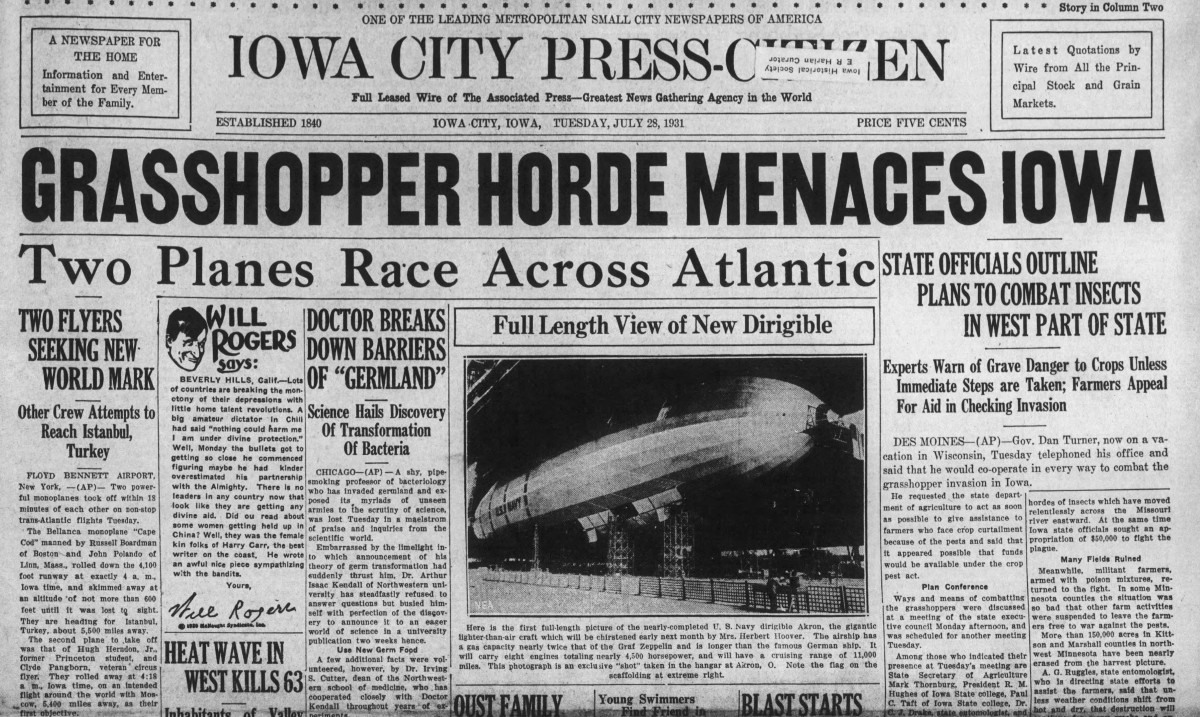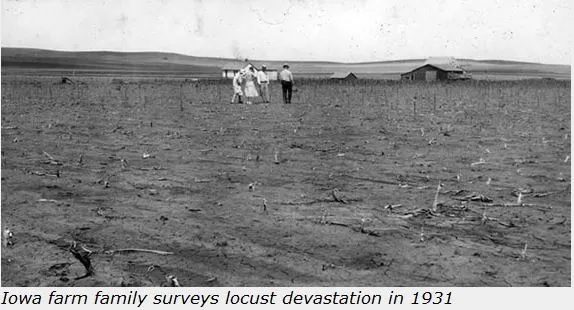
Source: NotesonIowa.com
On 26 July 1931 swarms of grasshoppers would descend on the American Midwest resulting in millions of acres of farmland to be destroyed.
In 1931 the United States was in the throes of the Great Depression with many out of work, rural banks closing, capital to invest in industries limited, and the cost of living hard for most Americans. The American Midwest, which supplied much of the nation’s needed grain and other foods, was hit hard not only by the bad economic times but a drought as well. Agriculture faces many threats but one of the most serious are voracious insects such as grasshoppers and locusts. There had been such pestilence before in America. There had been one in July 1874 when Rocky Mountain Locusts swarmed through North Dakota to Texas destroying crops. There too the Midwest was beset by drought, which is considered to be a cause of large swarms being formed to find food.
Locusts and grasshoppers are similar to each other, can look the same in many cases, but have differences as well. Both belong to the same family- Acrididae- and can look the same but have differences as well. Grasshoppers are found worldwide while locusts are generally found in Africa and Asia. Both are solitary meaning after they are born, except for mating, they do not have much contact with others of their kind. Both eat plants and will devour the entire plant. Grasshoppers tend to eat a more varied diet than locusts. Both however can swarm when foods become scarce. Locusts though actually change color, unlike grasshoppers, when they swarm. Both though are a pestilence to farmers.
By July 1931, severe drought had devastated Iowa, Nebraska, and South Dakota. On July 26, swarms of grasshoppers descended and began eating all the cornstalks right down to the ground. The swarms were so massive that they actually blotted out the sun in some areas. They covered everything and seemed everywhere. You could not walk without stepping through them as they ate their way across the land. Anything that stored grains, unless well sealed, would be targeted as well if they could find a way in.

Source: NotesonIowa.com
The result were farms completely devastated once the grasshoppers were finished. The grasshoppers consumed every part of the cornstalk leaving nothing behind before they moved on. President Hoover allocated federal aid to help farmers after the crisis. However, the combined problems of the drought, the Great Depression, and the grasshoppers caused many to close up and move elsewhere to start over. Grasshoppers are still a threat today, somewhat minimized with pesticides, but can still swarm when drought limits their food supply.
Footnote
There was a major grasshopper swarm near Albuquerque, New Mexico in 2014. Due to drought and limited vegetation, the swarm headed to both urban and suburban centers. The swarm was so thick that it was picked up on radar. The grasshoppers destroyed or damaged home lawns, outdoor gardens, and just like in 1931 were everywhere.
ABC News. “Grasshopper Swarms so Dense They Show up on Radar.” ABC News, 2 June 2014, www.abcnews.go.com/blogs/headlines/2014/06/grasshopper-swarms-so-dense-they-show-up-on-radar
Sources
Grasshopper Plague of the Great Plains – Legends of Kansas. (n.d.). https://legendsofkansas.com/grasshopper-plague/
Green, J. (2021, May 14). The Most Devastating Plagues in US History Caused by Insects. 24/7 Wall St. Retrieved July 25, 2024, from https://247wallst.com/special-report/2021/05/14/the-most-devastating-plagues-in-us-history-caused-by-insects/
Mason, K. (2022, July 27). Iowa History Daily: July 27 – Great Grasshopper Horde of ’31. Notes on Iowa. https://www.notesoniowa.com/post/iowa-history-daily-july-27-great-grasshopper-horde-of-31
Sullivan, M. (2024e, July 23). South Dakota governor begs for federal assistance over grasshopper plague. HISTORY. https://www.history.com/this-day-in-history/grasshoppers-bring-ruin-to-midwest
Documentaries
Nebraska Public Media. (2012, May 11). A Plague of Locusts | Nebraska Stories [Video]. YouTube. https://www.youtube.com/watch?v=To48K5E4ULM
The History Guy: History Deserves to Be Remembered. (2020, August 17). The Great Kansas Grasshopper Plague of 1874 [Video]. YouTube. https://www.youtube.com/watch?v=FxqgBWxLZa0
Suggested Reading
Atkins, A. (1984). Harvest of Grief: Grasshopper Plagues and Public Assistance in Minnesota, 1873-78. Minnesota Historical Society.
Lockwood, J. A. (2005). Locust: The Devastating Rise and Mysterious Disappearance of the Insect that Shaped the American Frontier. Basic Books.
Titanic News Channel is a participant in the Amazon Services LLC Associates Program, an affiliate advertising program designed to provide a means for sites to earn advertising fees by advertising and linking to Amazon.com.
